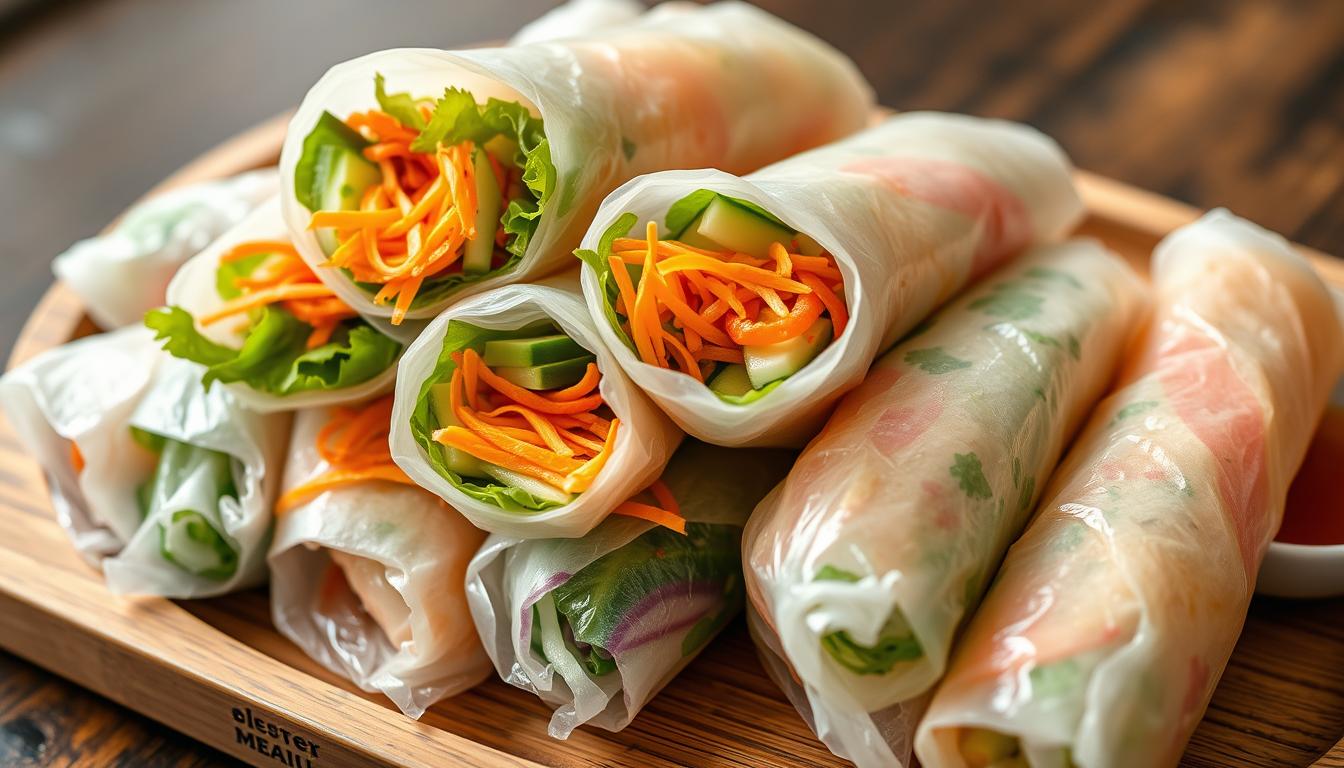When I first made homemade vegetarian spring rolls, my kitchen became a playground. The fresh wraps filled with vibrant veggies changed my cooking game. Now, I love making appetizers and light meals.
Spring rolls are more than food; they’re a chance to get creative. Your vegetarian spring rolls can be a journey of flavors and health. With just 30 minutes, you can make veggie rolls that are as good as restaurant ones.
Imagine making 12 spring rolls with fresh lettuce, red cabbage, and carrots. Each bite has only 130 calories and is full of nutrients. These aren’t just snacks; they’re a healthy, fun experience in your kitchen.
Vegetarian spring rolls are for everyone, whether you’re experienced or new to cooking. They offer gluten-free and vegan options. These rolls make eating healthy both tasty and enjoyable.
Understanding Traditional Spring Roll Origins and History
Spring rolls are a journey through time and across continents. They are a key part of Asian cuisine, especially in China. Their story begins in the Tang Dynasty (618-907 AD), where they were a special dish for seasonal celebrations.
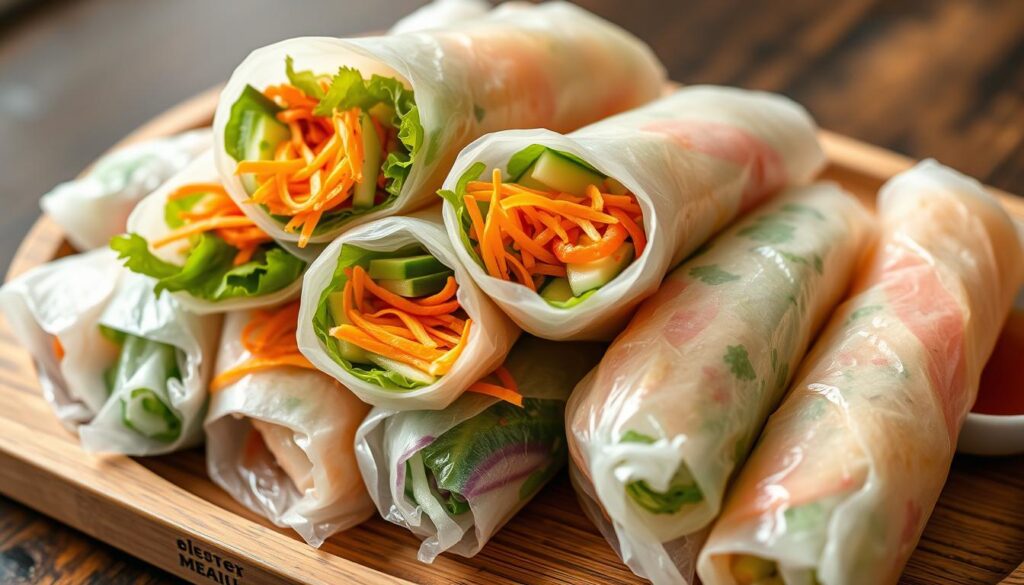
Spring rolls are linked to the Chinese Spring Festival, a time of new beginnings. Meatless spring rolls were a way to show off fresh spring vegetables.
Evolution from Chinese Spring Festival
In the Tang Dynasty, spring rolls were more than food. They were a sign of wealth. Rich families made fancy versions with rare ingredients. The shape of spring rolls meant wealth and good luck, making them a favorite at festivals.
- Originated in East and Southeast Asia
- Traditionally consumed during Spring Festival
- Symbolized wealth and new beginnings
Spread Across Asian Cuisine
As people moved, spring rolls changed to fit local tastes. Each place made its own version:
| Country | Spring Roll Variation | Unique Characteristics |
|---|---|---|
| Vietnam | Gỏi cuốn | Served cold, uses rice paper |
| Japan | Harumaki | Often served with mustard or soy sauce |
| Philippines | Lumpia | Introduced in the 17th century |
Modern Adaptations
Today, spring rolls are loved worldwide. Chefs and cooks keep making new versions. They stay true to tradition but also try new things.
Essential Ingredients for Perfect Vegetable Spring Rolls
Making tasty vegetarian spring rolls begins with picking the right ingredients. Your journey to making restaurant-quality spring rolls starts with understanding the key components. These components turn simple ingredients into a culinary masterpiece.
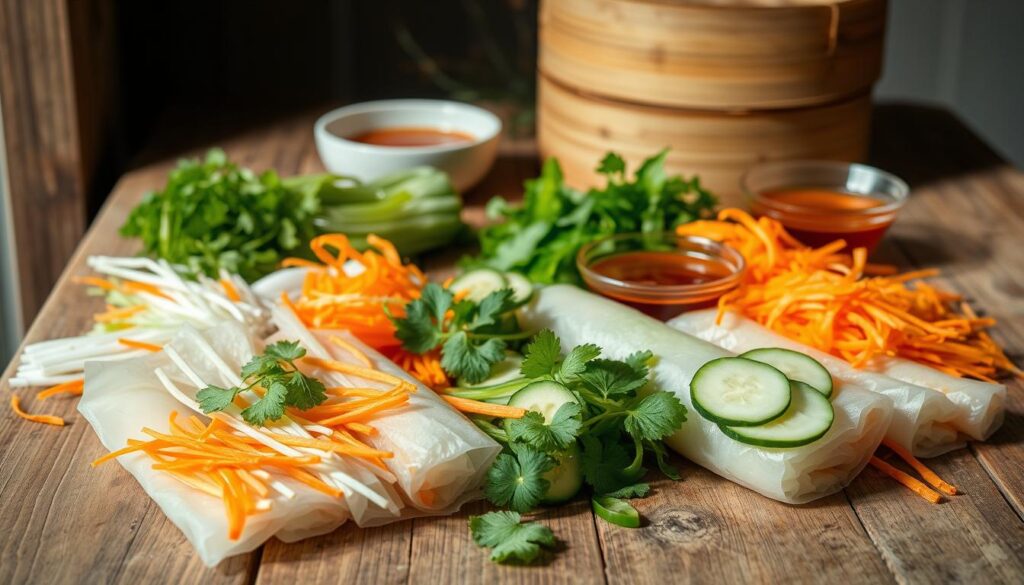
Spring Roll Wrapper Selection
Choosing the right spring roll wrappers is key for that perfect crispy texture. You’ll want to explore different types of spring roll wrappers, including:
- Rice paper wrappers
- Wheat-based wrappers
- Frozen spring roll pastry sheets
The best spring roll wrappers should be thin, flexible, and easy to work with. This makes creating your healthy spring roll fillings a breeze.
Fresh Vegetable Selection
Your vegetable selection is crucial for the spring rolls. Aim for a colorful and crunchy mix of fresh ingredients:
- 2 carrots, sliced into matchsticks
- 140 grams of thinly sliced cabbage
- ½ red bell pepper, deseeded and sliced
- 140 grams of fresh bean sprouts
- Green onions
- Fresh herbs like cilantro and mint
Sauce and Seasoning Components
To elevate your spring rolls, add these flavor-packed ingredients:
- 4 tablespoons light soy sauce
- 2 tablespoons hoisin sauce
- 2 cloves of minced garlic
- ¼ teaspoon white pepper
- 2 teaspoons cornflour mixed with cold water
Pro tip: The key to perfect spring roll wrappers is keeping them moist and pliable. Work quickly and cover unused wrappers with a damp cloth to prevent drying out.
Kitchen Tools and Equipment Needed
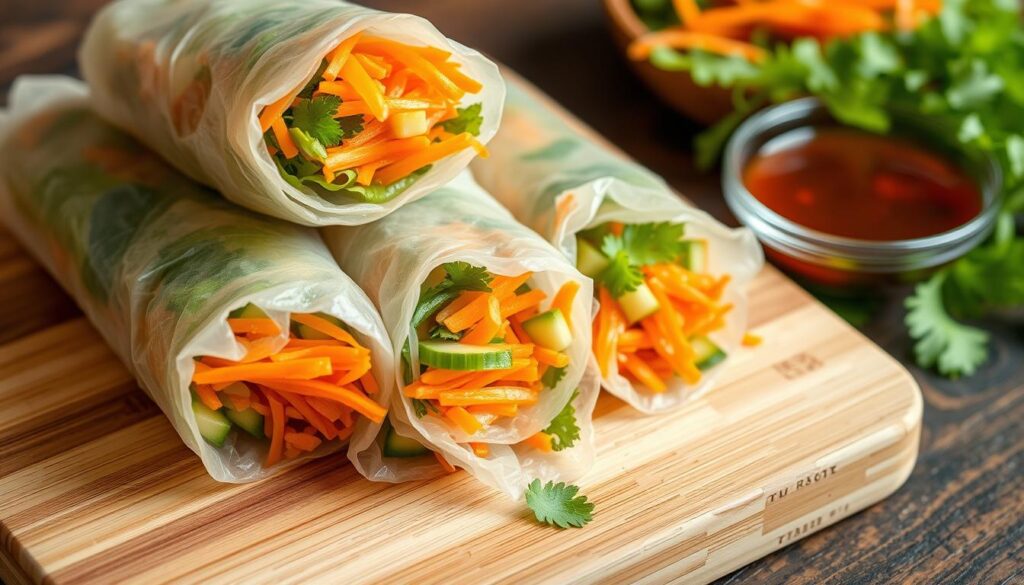
To make tasty plant-based spring rolls, you need some key kitchen tools. These tools make preparing your veggie wraps easy and fun. A sharp chef’s knife is essential for cutting veggies into thin, even strips. This makes your spring rolls look great.
Here are the must-have tools for making perfect vegetarian spring rolls:
- Cutting board with non-slip surface
- Large mixing bowls for ingredient preparation
- Shallow pan for soaking rice paper wrappers
- Clean lint-free kitchen towel
- Measuring cups and spoons
- Julienne peeler for perfect vegetable strips
Having the right tools can change your cooking experience. A clean workspace with good lighting and all ingredients ready will help you make beautiful spring rolls. Make sure to have your rice paper, fresh herbs, and veggies ready before you start.
Pro tip: Keep a small bowl of warm water nearby when working with rice paper. This ensures smooth and consistent wrapping of your spring rolls. It helps prevent tearing and makes wrapping more enjoyable.
Vegetarian Spring Rolls recipes: Step-by-Step Guide
Making tasty vegetarian spring rolls at home is simple. This guide will show you how to make veggie rolls that everyone will love. With a few easy steps, you’ll be a pro at making spring rolls in no time.
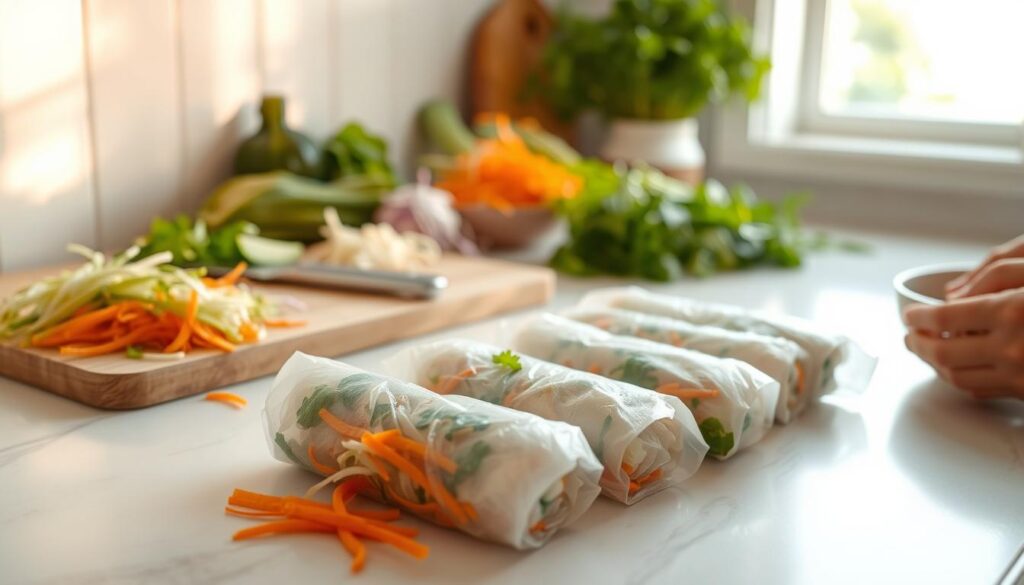
Preparing the Filling
The secret to great vegetarian spring rolls is the filling. First, get your fresh ingredients ready:
- 1 cup thinly sliced napa cabbage
- 1/2 cup grated carrots
- 1/3 cup chopped green bell peppers
- 1/4 cup French beans
- 1 tablespoon soy sauce
- 1 teaspoon sesame oil
Heat your veggies on high for 4-5 minutes. Pro tip: Cook them fast to keep them crisp and bright!
Rolling Technique
Learning to roll is key for perfect spring rolls. Here’s how to do it:
- Soak rice paper in warm water for 10-15 seconds
- Place on a clean, damp kitchen towel
- Add 2-3 tablespoons of filling near the bottom edge
- Fold bottom edge over filling
- Fold in side edges
- Roll tightly upward
- Seal with a cornstarch paste
Cooking Methods
You can cook your veggie rolls in different ways. Deep frying at 180-190°C makes them crispy. Baking at 180°C is a healthier choice. Air frying at 200°C for 8-10 minutes is also great.
Each spring roll cooks in 2-3 minutes until golden. Cook 2-3 rolls at once to keep the oil temperature right.
Mastering the Perfect Filling Combination
Making delicious plant-based spring rolls is like creating a work of art. It’s all about finding the right mix of flavors, textures, and colors. The right filling can turn a simple roll into a feast for the senses.
When making healthy spring roll fillings, keep these tips in mind:
- Crunch factor: Shredded carrots and purple cabbage
- Freshness: Crisp lettuce and cucumber
- Herbal notes: Cilantro, mint, and Thai basil
- Optional heat: Jalapeños or chili garlic sauce
Plant-based spring rolls can have a wide range of vegetables for exciting tastes. Use about 2 heaping cups each of shredded carrots, purple cabbage, and mung bean sprouts. This mix is not only healthy but also looks great.
Pro tip: Keep your filling light and balanced. Use about 2 to 3 tablespoons of veggie mix per roll. This avoids overstuffing and makes rolling easier. Add thin rice noodles for extra texture – about 1 to 2 tablespoons per roll is perfect.
Try different mixes to find your favorite. Spring rolls are very flexible. You can change ingredients based on what’s in season or what you have at home.
Expert Tips for Wrapper Handling and Storage
Learning to work with spring roll wrappers can really boost your cooking skills. Whether you’re making veggie wraps or traditional spring rolls, knowing how to handle these ingredients is key.
Proper Storage Techniques
Storing spring roll wrappers needs attention. These rice paper wrappers dry out fast if not stored right. Here are some important storage tips:
- Keep unopened packages in a cool, dry place
- Store opened wrappers in an airtight container
- Use within recommended expiration date
- Protect from direct sunlight and humidity
Working with Rice Paper Like a Pro
Rice paper needs a gentle touch and specific techniques. When making your veggie wraps, follow these expert tips:
| Technique | Details |
|---|---|
| Water Temperature | 90-95°F (32-35°C) |
| Soaking Time | 10 seconds |
| Drying Time | 30 seconds on a towel |
Avoiding Common Wrapping Mistakes
Wrapping spring rolls can be tricky, but with practice, you’ll get better. Remember to work quickly and confidently when handling your wrappers. Here are some common mistakes to avoid:
- Don’t oversoak rice paper
- Avoid overfilling your wraps
- Ensure a tight, secure roll
- Work on a clean, slightly damp surface
With these tips, you’ll be making stunning spring roll wrappers that will wow your friends and family. Keep practicing, and soon you’ll be a pro at wrapping spring rolls!
Homemade Dipping Sauce Variations
Make your vegan spring rolls special with homemade dipping sauces. These sauces can turn simple appetizers into amazing dishes. They add a burst of flavor to every bite.
Here are three amazing sauce recipes to make your vegan spring rolls irresistible:
Spicy Peanut Sauce
- ¾ cup coconut milk
- 2 tablespoons red curry paste
- ⅓ cup natural peanut butter
- 1 teaspoon soy sauce
- 1 tablespoon apple cider vinegar
- ¼ cup packed brown sugar
- ¼-⅓ cup water
Sweet and Spicy Sauce
- ¼ cup rice vinegar
- ½ cup + 1 tablespoon water
- ¼ cup sugar
- 2 cloves minced garlic
- 1 teaspoon soy sauce
- 1 red chili or 1 tablespoon red pepper flakes
- 2 teaspoons cornstarch
Yum Sauce
- ½ cup mayo
- 1 tablespoon ketchup
- ¼ teaspoon garlic powder
- ¼ teaspoon paprika
- ¼ teaspoon cayenne
- ½ teaspoon salt
- 1-2 tablespoons water
Each sauce is quick to make, ready in just 5 minutes. You’ll get about 12 servings. Tip: keep your sauces in an airtight container in the fridge for up to 5 days.
Nutritional Insights
| Nutrient | Per Serving |
|---|---|
| Calories | 94 kcal |
| Carbohydrates | 14 g |
| Protein | 2 g |
| Fat | 3 g |
Feel free to try out these sauces. Mix and match to find your favorite flavors for your vegan spring rolls!
Cooking Methods: Deep Frying vs. Baking
Making the perfect vegetarian appetizers means knowing how to cook them right. You can choose between deep frying and baking. Each method changes the taste and healthiness of these tasty treats.
There are two main ways to cook vegetarian spring rolls: deep frying and baking. Both methods help make these appetizers crispy and delicious.
Deep Frying Technique
Deep frying gives spring rolls their famous crispy outside. Here’s how to do it right:
- Use neutral oil heated to 370°F
- Fry in small batches for 2-3 minutes
- Ensure oil depth of 5-6 cups
- Drain on paper towels to remove excess oil
Baking Method
Baking is a healthier way to make spring rolls:
- Preheat oven to 400°F
- Brush spring rolls with a light oil coating
- Bake for 12-15 minutes
- Rotate halfway through for even crispiness
Pro tip: For extra crunch when baking, place spring rolls on a wire rack. This helps air circulate and prevents them from getting soggy.
Nutritional Comparison
Let’s look at how cooking methods affect nutrition:
- Deep-fried spring rolls: About 143 calories per serving
- Baked spring rolls: Around 73 calories per serving
- Fat content drops from 3.4g to 0.3g when baking
Choosing your cooking method can make these appetizers healthier without losing flavor.
Make-Ahead and Storage Solutions
Preparing vegetarian spring rolls ahead of time can save you kitchen time. You can prep your veggie rolls to make things easier without losing flavor or quality.
When planning your vegetarian spring rolls recipes, consider these storage strategies:
- Vegetable Preparation: Chop and store vegetables in an airtight container up to 2-3 days in advance
- Rice Paper Management: Keep wrappers sealed in their original packaging to prevent drying
- Refrigeration: Store prepared spring rolls for 3-4 days maximum
Nutritional considerations are crucial when preparing make-ahead spring rolls. A single vegetarian spring roll typically contains:
| Nutritional Component | Amount |
|---|---|
| Calories | 116 kcal |
| Total Fat | 4.5g |
| Carbohydrates | 5.2g |
| Protein | 3.9g |
For optimal freshness, consume your veggie rolls within 12-24 hours of preparation. When storing, wrap rolls individually in damp paper towels and place in an airtight container. This keeps them moist and prevents sticking.
Pro tip: If freezing is necessary, separate rolls with parchment paper to prevent them from clumping together. Frozen spring rolls can last up to 3 months when properly sealed.
Health Benefits and Nutritional Information
Discover the amazing health benefits of healthy spring roll fillings. They can change your diet for the better. Plant-based spring rolls are a tasty way to eat more veggies and keep calories low. Each roll has about 80-110 calories, perfect for those watching their diet.
Nutritional highlights of these tasty rolls include:
- Low-calorie content (80-153 calories per serving)
- Minimal fat (3.5-4 grams per roll)
- Moderate carbohydrate levels (8.5-13 grams)
- Protein content of about 2 grams per roll
The nutrient profile of healthy spring roll fillings is impressive. Ingredients like capsicum, cabbage, and carrots are full of nutrients. Capsicum, for example, is packed with Vitamin C, boosting your immune system and skin health.
Fiber is another big plus of plant-based spring rolls. Each roll has about 1-3 grams of fiber. This helps you meet your daily fiber needs of 21-38 grams. The mix of veggies ensures you get all the nutrients you need while enjoying a delicious meal.
Pro tip: Baking your spring rolls instead of deep-frying cuts down on calories and fat. This makes them a healthier option for your diet.
Serving Suggestions and Presentation Ideas
Making vegetarian appetizers like vegan spring rolls is an art. It’s not just about cooking. The right presentation can make your dish stand out, impressing everyone at any event.
Plating Techniques to Impress
Your spring rolls need a beautiful presentation. Here are some ideas:
- Use rectangular white plates for elegant contrast
- Arrange rolls diagonally with varied heights
- Garnish with fresh herbs like cilantro or mint
- Create a colorful sauce drizzle underneath
Perfect Accompaniment Options
Enhance your vegetarian appetizers with the right sides and drinks. The right pairings make for a memorable meal.
| Dipping Sauce | Beverage Pairing |
|---|---|
| Peanut Sauce | Green Tea |
| Sweet Chili Sauce | Thai Iced Tea |
| Hoisin Sauce | Jasmine Tea |
Pro tip: Serve your vegan spring rolls warm and crisp. This ensures every bite is full of flavor and texture. Offering different dipping sauces lets guests tailor their meal.
Conclusion
Making delicious vegetarian spring rolls is more than cooking. It’s an art that lets you explore endless flavors. You’ve learned to turn simple ingredients into vibrant, nutritious rolls that wow everyone.
Every spring roll you make is a chance to show off your creativity. With just 144 calories and 7g of protein, they’re both tasty and healthy. You can try different veggies, herbs, and fillings to keep your meals exciting.
Your skills in making spring rolls will help you in many future cooking projects. Whether it’s a quick lunch, a dinner party, or trying new flavors, these recipes are a great choice. They’re healthy and delicious, making them a must-have in your kitchen.
So, trust your instincts and keep exploring the world of spring rolls. Your culinary journey is just starting, and the possibilities are endless!

